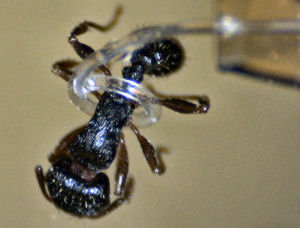22 June 2015
Robots get micro-tentacles to handle delicate objects
by Will Parker
 Using a transparent elastomer, Iowa State University scientists have created tiny tentacles that robots can wrap around delicate objects to handle them safely. The spiraling microrobotic tentacles are described in a research paper published in the journal Scientific Reports.
Using a transparent elastomer, Iowa State University scientists have created tiny tentacles that robots can wrap around delicate objects to handle them safely. The spiraling microrobotic tentacles are described in a research paper published in the journal Scientific Reports.
Demonstrating how one of the tentacles encircled an ant's thorax, softly trapping the insect, lead researcher Jaeyoun Kim said; "most robots use two fingers and to pick things up they have to squeeze, but these tentacles wrap around very gently." Kim's development team believes the new micro-tentacle would be ideal for medical applications because they won't damage tissues or blood vessels.
Their paper describes how they fabricated microtubes just one-third of an inch long and less than a hundredth of an inch wide. The tubes are made from PDMS, a transparent elastomer that can be a liquid or a soft, rubbery solid.
The researchers sealed one end of the tube and pumped air in and out. The air pressure and the microtube's asymmetrical wall thickness created a circular bend. They further describe how they added a small lump of PDMS to the base of the tube to amplify the bend and create a two-turn spiraling, coiling action.
"Spiraling tentacles are widely utilized in nature for grabbing and squeezing objects," Kim explained. "There have been continuous soft-robotic efforts to mimic them..., but the life-like, multi-turn spiraling motion has been reproduced only by centimeter-scale tentacles so far. [Previously] at millimeter and sub-millimeter scales, they could bend only up to a single turn."
Kim said the project was an overlap of two fields of robotics. "There's microrobotics, where people want to make robots smaller and smaller. And there's soft robotics, where people don't want to make robots out of iron and steel. I want to pioneer new work in the field with both microscale and soft robotics."
Related:
Discuss this article in our forum
Memristor artificial synapse circuit demonstrated
Spring-assisted exoskeleton beats evolution
Robo-cat offers speed and agility for search and rescue
Tiny robotic insect makes first controlled flight
Source: Iowa State University
